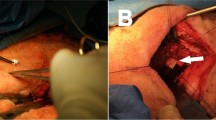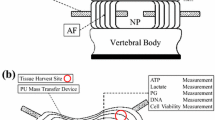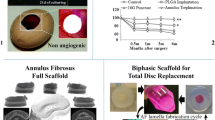Abstract
Recurrent disc herniation is frequently observed due to leakage of nucleus pulposus through injured anulus fibrosus. There is no effective treatment to prevent recurrent disc herniation yet. In this study, we proposed to implant non-cell-based materials into the porcine disc to stimulate the growth of fibrous tissue and thereby increase the disc functional integrity. The disc herniation was simulated by anular punctures using the spinal needles. Four clinically used implantation materials, i.e., gelfoam, platinum coil, bone cement and tissue glue, were delivered into the discs via percutaneous spinal needles. Two months after the surgery, the swine were killed. The degree of disc integrity of intact, naturally healed and implanted discs, was examined by quantitative discomanometry apparatus. We found the disc injury could not recover after 2 months of healing, and the disc implantation affected the degree of disc integrity. The disc integrity of gelfoam-implanted discs was better than that of coil-, bone cement-, and glue-implanted discs. The implantation of non-cell-based material was proved to be a potentially clinically applicable method to recover the integrity of injured discs and to prevent recurrent disc herniation.






Similar content being viewed by others
References
An HS, Takegami K, Kamada H, Nguyen CM, Thonar EJ, Singh K, Andersson GB, Masuda K (2005) Intradiscal administration of osteogenic protein-1 increases intervertebral disc height and proteoglycan content in the nucleus pulposus in normal adolescent rabbits. Spine 30:25–31; discussion 31–32
An HS, Thonar EJ, Masuda K (2003) Biological repair of intervertebral disc. Spine 28:S86–S92
Aota Y, An HS, Homandberg G, Thonar EJ, Andersson GB, Pichika R, Masuda K (2005) Differential effects of fibronectin fragment on proteoglycan metabolism by intervertebral disc cells: a comparison with articular chondrocytes. Spine 30:722–728
Forseth M, O’Grady K, Toriumi DM (1992) The current status of cyanoacrylate and fibrin tissue adhesives. J Long Term Eff Med Implants 2:221–233
Fye MA, Southern EP, Panjabi MM, Cholewicki J (1998) Quantitative discomanometry: technique and reproducibility in vitro. J Spinal Disord 11:335–340
Gaston P, Marshall RW (2003) Survival analysis is a better estimate of recurrent disc herniation. J Bone Joint Surg Br 85:535–537
Gosain AK, Lyon VB (2002) The current status of tissue glues: part II. For adhesion of soft tissues. Plast Reconstr Surg 110:1581–1584
Gruber HE, Johnson TL, Leslie K, Ingram JA, Martin D, Hoelscher G, Banks D, Phieffer L, Coldham G, Hanley EN Jr (2002) Autologous intervertebral disc cell implantation: a model using Psammomys obesus, the sand rat. Spine 27:1626–1633
Hamadouche M, Sedel L (2000) Ceramics in orthopaedics. J Bone Joint Surg Br 82:1095–1099
Hirayama J, Yamagata M, Ogata S, Shimizu K, Ikeda Y, Takahashi K (2006) Relationship between low-back pain, muscle spasm and pressure pain thresholds in patients with lumbar disc herniation. Eur Spine J 15:41–47
Hitchon PW, Eichholz K, Barry C, Rubenbauer P, Ingalhalikar A, Nakamura S, Follett K, Lim TH, Torner J (2005) Biomechanical studies of an artificial disc implant in the human cadaveric spine. J Neurosurg Spine 2:339–343
Iencean SM (2000) Lumbar intervertebral disc herniation following experimental intradiscal pressure increase. Acta Neurochir (Wien) 142:669–676
Joshi A, Fussell G, Thomas J, Hsuan A, Lowman A, Karduna A, Vresilovic E, Marcolongo M (2006) Functional compressive mechanics of a PVA/PVP nucleus pulposus replacement. Biomaterials 27:176–184
Joshi A, Mehta S, Vresilovic E, Karduna A, Marcolongo M (2005) Nucleus implant parameters significantly change the compressive stiffness of the human lumbar intervertebral disc. J Biomech Eng 127:536–540
Kallmes DF, Helm GA, Hudson SB, Altes TA, Do HM, Mandell JW, Cloft HJ (1999) Histologic evaluation of platinum coil embolization in an aneurysm model in rabbits. Radiology 213:217–222
Kayanja MM, Ferrara LA, Lieberman IH (2004) Distribution of anterior cortical shear strain after a thoracic wedge compression fracture. Spine J 4:76–87
Klara PM, Ray CD (2002) Artificial nucleus replacement: clinical experience. Spine 27:1374–1377
Kotani Y, Cunningham BW, Abumi K, Dmitriev AE, Ito M, Hu N, Shikinami Y, McAfee PC, Minami A (2005) Multidirectional flexibility analysis of cervical artificial disc reconstruction: in vitro human cadaveric spine model. J Neurosurg Spine 2:188–194
Lin EP, Ekholm S, Hiwatashi A, Westesson PL (2004) Vertebroplasty: cement leakage into the disc increases the risk of new fracture of adjacent vertebral body. AJNR Am J Neuroradiol 25:175–180
Mannion AF, Dvorak J, Muntener M, Grob D (2005) A prospective study of the interrelationship between subjective and objective measures of disability before and 2 months after lumbar decompression surgery for disc herniation. Eur Spine J 14:454–465
Masuda K, Oegema TR Jr, An HS (2004) Growth factors and treatment of intervertebral disc degeneration. Spine 29:2757–2769
Maurer P, Bekes K, Gernhardt CR, Schaller HG, Schubert J (2004) Comparison of the bond strength of selected adhesive dental systems to cortical bone under in vitro conditions. Int J Oral Maxillofac Surg 33:377–381
Mizuno H, Roy AK, Zaporojan V, Vacanti CA, Ueda M, Bonassar LJ (2005) Biomechanical and biochemical characterization of composite tissue-engineered intervertebral discs. Biomaterials 27:362–370
Negvesky GJ, Butrus SI, Abifarah HA, Lee YC, Yalkowsky SH (2000) Ocular gelfoam disc-applicator for pupillary dilation in humans. J Ocul Pharmacol Ther 16:311–315
Panjabi M, Brown M, Lindahl S, Irstam L, Hermens M (1988) Intrinsic disc pressure as a measure of integrity of the lumbar spine. Spine 13:913–917
Saruhashi Y, Mori K, Katsuura A, Takahashi S, Matsusue Y, Hukuda S (2004) Evaluation of standard nucleotomy for lumbar disc herniation using the Love method: results of follow-up studies after more than 10 years. Eur Spine J 13:626–630
Schechtman H, Robertson PA, Broom ND (2006) Failure strength of the bovine caudal disc under internal hydrostatic pressure. J Biomech 39:1401–1409
Solberg TK, Nygaard OP, Sjaavik K, Hofoss D, Ingebrigtsen T (2005) The risk of “getting worse” after lumbar microdiscectomy. Eur Spine J 14:49–54
Songer MN, Ghosh L, Spencer DL (1990) Effects of sodium hyaluronate on peridural fibrosis after lumbar laminotomy and discectomy. Spine 15:550–554
Southern EP, Fye MA, Panjabi MM, Patel TC, Cholewicki J (2000) Disc degeneration: a human cadaveric study correlating magnetic resonance imaging and quantitative discomanometry. Spine 25:2171–2175
Takegami K, An HS, Kumano F, Chiba K, Thonar EJ, Singh K, Masuda K (2005) Osteogenic protein-1 is most effective in stimulating nucleus pulposus and annulus fibrosus cells to repair their matrix after chondroitinase ABC-induced in vitro chemonucleolysis. Spine J 5:231–238
Tenjin H, Fushiki S, Nakahara Y, Masaki H, Matsuo T, Johnson CM, Ueda S (1995) Effect of Guglielmi detachable coils on experimental carotid artery aneurysms in primates. Stroke 26:2075–2080
Trail IA, Powell ES, Noble J, Crank S (1992) The role of an adhesive (Histoacryl) in tendon repair. J Hand Surg [Br] 17:544–549
Uzvolgyi E, Katona A, Kertai P (1990) Tumor cell implantation with the use of Gelaspon gelatin sponge disc. Cancer Lett 51:1–5
Veloudios A, Kratky V, Heathcote JG, Lee M, Hurwitz JJ, Kazdan MS (1996) Cyanoacrylate tissue adhesive in blepharoplasty. Ophthal Plast Reconstr Surg 12:89–97
Wang DH, Makaroun M, Webster MW, Vorp DA (2001) Mechanical properties and microstructure of intraluminal thrombus from abdominal aortic aneurysm. J Biomech Eng 123:536–539
Wang JL, Panjabi MM, Kato Y, Nguyen C (2002) Radiography cannot examine disc injuries secondary to burst fracture: quantitative discomanometry validation. Spine 27:235–240
Wilke HJ, Neef P, Caimi M, Hoogland T, Claes LE (1999) New in vivo measurements of pressures in the intervertebral disc in daily life. Spine 24:755–762
Wu MC, Hsiao CT (2003) Breeds of the laboratory swine in ISO certified swine farm and their characteristics. In: Chinese Society of Laboratory Animal Sciences Annual Meeting, Taipei
Acknowledgment
This study was supported by NTU Hospital, NTU Animal Hospital, the National Science Council, Taiwan (NSC 92-2320-B-002-091, NSC 94-2320-B-002-035), and National Health Research Institute, Taiwan (NHRI-EX94-9425EI). The use of animals was approved by the Animal Care and Use Committee, National Taiwan University.
Author information
Authors and Affiliations
Corresponding author
Rights and permissions
About this article
Cite this article
Wang, YH., Kuo, TF. & Wang, JL. The implantation of non-cell-based materials to prevent the recurrent disc herniation: an in vivo porcine model using quantitative discomanometry examination. Eur Spine J 16, 1021–1027 (2007). https://doi.org/10.1007/s00586-007-0306-1
Received:
Revised:
Accepted:
Published:
Issue Date:
DOI: https://doi.org/10.1007/s00586-007-0306-1




